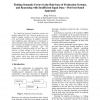969 search results - page 161 / 194 » Recursive Petri nets |
CMOT
2006
13 years 7 months ago
2006
This contribution investigates the function of emotion in relation to norms, both in natural and artificial societies. We illustrate that unintentional behavior can be normative an...
DSS
2006
13 years 7 months ago
2006
Workflow research is commonly concerned with optimization, modeling, and dependency. In this research, we however address a more fundamental issue. By modeling humans and machines...
IJSEKE
2008
13 years 7 months ago
2008
- Multi-agent systems (MASs) have become an important topic in distributed systems research. These distributed multi-agent systems call for special software modeling methods that e...
JCIT
2008
13 years 7 months ago
2008
Two simple but practical production systems are modeled using Petri Nets. Petri-net models are very useful in finding semantic errors like generalization error and missing conditi...
FUIN
2007
13 years 7 months ago
2007
We define Concurrent Turing Machines (CTMs) as Turing machines with Petri nets as finite control. This leads to machines with arbitrary many tape heads, thus subsuming any class ...

